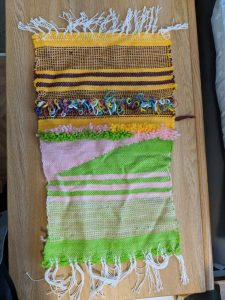Joy Zhou Weaving

Intention:
My starting inspiration for this piece was to test my technical skill in recreating an image onto a weaving. I started out with a black and white picture of Marilyn Monroe, and intended to treat the warps and the looms like a medium for pixel art, with the initial image dictating which“pixels” should be black or white. However, as I continued weaving, I felt too constrained, as if I was forced to follow the image even though I had full creative control over this weaving. Thus, I stopped following the Marilyn Monroe pattern halfway, and allowing me to follow my intuition and go with what I wanted to weave instead. I attempted to create a pattern as I worked on it, rather than following set guidelines, and it was interesting how an abstract pattern has so many interpretations from different people.
Process:
For this piece I decided to only use black and white yarn, since I really wanted the pattern to be the focus, rather than texture. This is also the reason why I did not incorporate any techniques to make the weaving look three dimensional, such as rya knotting, or use any unconventional material. I wanted people to look at the pattern and try to interpret the shapes, rather than having their eyes wander. While weaving the bottom portion, I weaved in around three or five strands of yarn at once (there was a portion where I weaved 6 or 7 strands of alternating black and white yarn), which was very time consuming but also very satisfying. The hard work definitely paid off when you can see the pattern from far away. Towards the top half, I only used two strands of yarn, black and white, and incorporated the white warp to test halftones. Because the technique I used was different (crossing the two strands of yarn instead of going under the warp), the top part of the weaving was much less dense than the bottom half, giving it a slightly less fluffy texture. This was not my intention; I was merely trying to incorporate more techniques, but I’m happy it turned out the way that it did. The juxtaposition between the top half, which is more geometrical, and the bottom half, which is more freeform, is contrasted even more.
Learning:
While weaving this project, I have much more respect for people who are able to weave patterns onto clothes, as I know how time consuming and tiring it is. It was also interesting to listen to other people’s interpretation of such an abstract piece, and I am glad it allowed people to think outside of the box. I think if I were to continue, I’d still like to try and weave a set image onto my loom since I was unsuccessful this time.
 Sample Weaving
Sample Weaving